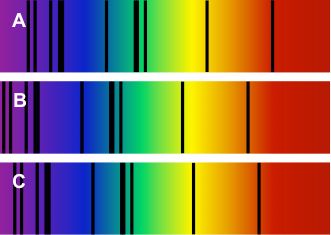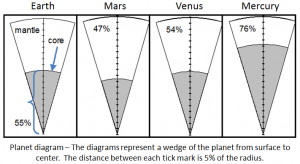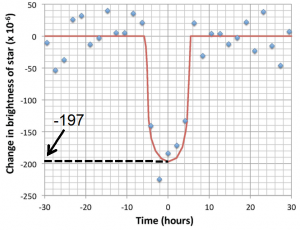Chapter 2 Answers
Review Answers:
- To see an event, light from that event must reach our eyes. Light travels very quickly (about 300,000,000 meters per second), but the universe is very, very large. Depending on how far away the event was, it could take billions of years for light to travel from the event to our eyes so we can see it. Astronomers take advantage of this fact to view the universe’s past.

Spectra for the sun and two galaxies. [Image by Karla Panchuk] - B is the spectrum from the Andromeda galaxy. We know that one spectrum represents the Sun, which is not moving toward or away from us. (Our orbit is not perfectly circular, but the small eccentricity is not a factor in this comparison.) We know that the Andromeda galaxy is on a collision course with us, so it is the exception to the rule that galaxies are moving away from us, and their light is red-shifted. That means the spectrum B which is shifted furthest to the left (blue-shifted) is Andromeda, and spectrum A which is furthest to the right (red-shifted) is a galaxy moving away from us. That means C is the Sun.
Spectra for the sun and two galaxies. [Image by Karla Panchuk] - The planetary system consisted of two Jupiter-sized gas giant planets. Gas giant planets contain large amounts of hydrogen, and hydrogen was plentiful in the early universe. In contrast, terrestrial planets have heavier elements, especially silica, iron, magnesium, and nickel, that had yet to be manufactured by stars. Those elements were not present in sufficient abundance to form terrestrial planets until much later.
- Closest to the sun we find the small, rocky, terrestrial planets with metal cores. Further out are the gas giant planets, which are the largest in the solar system. They consist mostly of hydrogen, and have cores of rock and ice. Beyond the gas giant planets are the ice giant planets, which are next largest. They have a mantle of ice (not just water ice but ammonia and methane ice), and a rocky core. Smaller objects in the solar system include rocky bodies within the asteroid belt between Mars and Jupiter, and bodies of ice and dust in the Kuiper belt and Oort cloud beyond Neptune.
- The frost line marks the distance from the Sun beyond which temperatures were cool enough to allow ice to form. This helps to explain why the terrestrial planets are closer to the Sun, and the Jovian and ice giant planets farther away. Mineral grains could solidify and begin to accrete closer to the Sun, forming terrestrial planets, because they have higher melting points. In contrast, water vapour, methane, and ammonia had to be farther from the Sun before they could freeze and begin to accrete.
- The objects are comets, and two places to find large numbers of comets in the solar system are the Oort cloud and the Kuiper belt. The bright dot the comets have noticed is the sun, and the adventurous comet returns displaying the consequences of the Sun’s energy blasting gases and dust from its surface.
- Planets are defined as having cleared their orbits of debris. Pluto is located within the Kuiper belt, so it shares its orbit with other objects. There are two other criteria in the definition of a planet: planets in our solar system must orbit the Sun, and they must have a spherical shape. Pluto satisfies both these criteria, but sadly the people deciding whether or not Pluto should be a planet are not amenable to a “best two out of three” compromise.
- Differentiation is the separation of materials within a planet such that dense materials sink to the core, and lighter materials float upward. In Earth’s case, the denser materials are iron and nickel, and the lighter materials are silicate minerals. In order for differentiation to happen, the entire planet must be melted.
- Thus far it appears that our solar system is unique compared to other planetary systems we have observed. In particular, some other planetary systems have gas giant planets very close to their star. The fact that we have terrestrial planets close to the Sun makes sense in terms of the frost line, but it does not seem to be a hard-and-fast rule in other planetary systems. Therefore, we can’t conclude from Kepler-452b’s position alone that it is a terrestrial planet.
- The rules to the accretion game mean that there are many complex interactions, so even a small difference in the starting conditions or in how the game goes in the beginning could have major implications in the end. For that reason, we shouldn’t expect to find a planetary system that matches ours in every minute detail. However, just because we haven’t found a similar planetary system does not mean one does not exist. Our planet-finding methods are biased toward discovering large planets orbiting close to their stars, whereas our solar system has small planets close to the Sun and larger ones farther away. That doesn’t mean our methods won’t eventually turn up a system like ours, just that they are more likely to turn up systems that are different.
Answers to Exercises:
Exercise 2.1 How do we know what other planets are like inside?
Table 2.2 Find the fraction of volume that is core Description Earth Mars Venus Mercury Planet density (uncompressed) in g/cm3 4.05 3.74 4.00 5.30 Percent core 16.8% 10.3% 15.8% 43.2% Table 2.3 Find the volume of the core for each planet Description Earth Mars Venus Mercury Unsqueezed planet volume – km3 1.47 x 1012 1.72 x 1011 1.22 x 1012 6.23 x 1010 Core volume – km3 2.48 x 1011 1.77 x 1010 1.92 x 1011 2.69 x 1010 Table 2.4 Find the percent of each planet’s radius that is core Description Earth Mars Venus Mercury Unsqueezed core radius in km 3900 1617 3581 1858 Unsqueezed planet radius in km 7059 3447 6623 2458 Percent of radius that is core (see diagram below) 55% 47% 54% 76% 
Planet diagram – the diagrams represent a wedge of the planet from surface to center. The distance between each tick mark is 5% of the radius. Image by Karla Panchuk.
Exercise 2.2 How do we know the sizes of exoplanets?

Plot showing how the star Kepler-452 dims as the planet Kepler-452b moves in front of it. Image by Karla Panchuk after Jenkins, J. et al, 2015, Discovery and validation of Kepler-452b: a 1.6REarth super Earth exoplanet in the habitable zone of a G2 star, Astronomical Journal, V 150, DOI 10.1088/0004-6256/150/2/56.]
Table 2.5 Calculate the radius of star Kepler-452 Description Sun Kepler-452 Ratio Temperature (degrees Kelvin) 5778 5757 1.0036 Luminosity (x 1026 Watts) 3.846 4.615 1.20 Radius (km) 696,300 768,317 * The temperatures of the sun and Kepler-452 are very similar, but the small difference is important. Keep 4 decimal places.
Table 2.6 Calculate the radius of planet Kepler-452b Decrease in brightness* Earth radius (km) Kepler-452b radius rplanet (km) Kepler-452b radius/ Earth radius 197 x 10-6 6378 10,784 1.7 * Because we know this is a decrease, you don’t need to keep the negative sign.
Answers for Chapter 2 were provided by Karla Panchuk.
Licenses and Attributions
“Physical Geology – 2nd Edition” by Steven Earle (Chapter 22 is written by Karla Panchuk) is licensed under CC BY 4.0 Adaptation: Renumbering, Remixing

